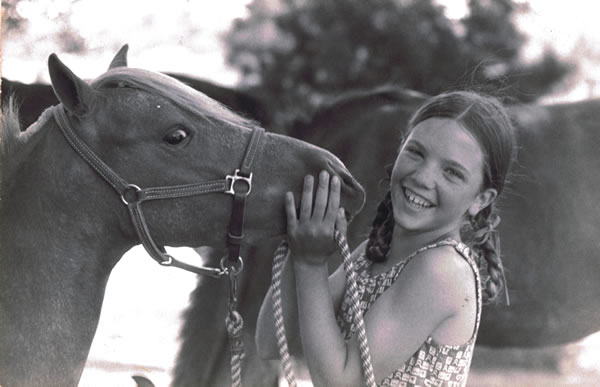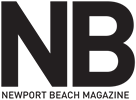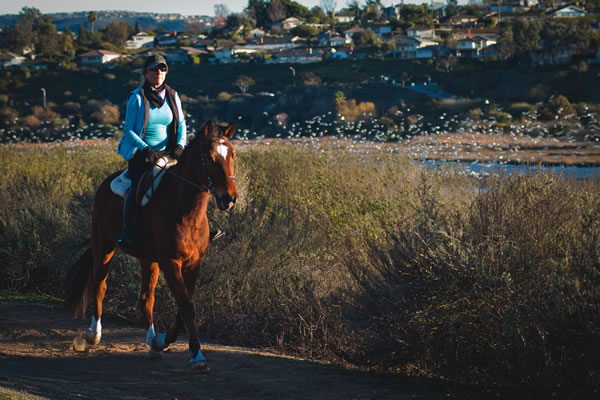Local horsewomen dig their heels in to keep Newport’s horse country alive. – By Cindy Hale | Photos by Bill Freeman
I grew up along the Newport coastline, so you probably think that my first impulse on sunny days was to grab my boogie board and head to the beach. But I was more likely to bypass the seaside accoutrements and reach for my saddle. I was the epitome of a horse-crazy girl. And fortunately, during my adolescent hay days of the 1970s and 80s, much of what is now Newport Beach was carpeted with large swaths of unplowed earth and a network of bridle paths—some maintained and manicured, others mere ribbons of dirt alongside asphalt—allowing me to ride unencumbered throughout the Back Bay.
Though long since officially christened the Upper Newport Bay Nature Preserve, the Back Bay was once a haven for giggling girls on horseback. I boarded my little sorrel mare, Honey, at the fairgrounds, and would trot her all the way down Mesa Drive to a rendezvous point at Irvine Boulevard. There I’d await the arrival of my pals aboard their horses. They were the ones I secretly envied, because as residents of the “tree streets” like Cypress, Acacia and Birch, they kept their horses in backyard stables. Yet once we joined together, any disparities in lifestyles or social status became delightfully moot. We’d ride into the Back Bay a united troop of horse lovers, eager for adventure and exploration.
Yet despite the inherent immaturities of youth, each of these forays was conducted with a sense of reverence. There was great beauty to behold, unlike anything else we could experience just a few blocks away. Tawny coyotes and yellow bobcats, teal-green ducks and herons the hue of storm clouds were our hosts. For countless hours we’d rein our horses along trails that meandered across sandy washes or through grasslands that tickled their bellies. Riding in the Back Bay was much like a visit to heaven on horseback.
From Heights to Homes
 The greatest alteration to these wistful memories isn’t the passage of time, but the earnest development of luxury homes that supplanted modest dwellings on rural lots. The transformation began in 1998, when the first portion of county land known as the Santa Ana Heights was annexed by the city of Newport Beach. Further annexations, particularly in 2002, encouraged a wave of real estate transactions. Modest ranchettes, erected in the 1950s and 1960s and home to corrals and chicken coops, were supplanted with luxury homes posh with circular driveways and koi ponds.
The greatest alteration to these wistful memories isn’t the passage of time, but the earnest development of luxury homes that supplanted modest dwellings on rural lots. The transformation began in 1998, when the first portion of county land known as the Santa Ana Heights was annexed by the city of Newport Beach. Further annexations, particularly in 2002, encouraged a wave of real estate transactions. Modest ranchettes, erected in the 1950s and 1960s and home to corrals and chicken coops, were supplanted with luxury homes posh with circular driveways and koi ponds.
Equestrian and horse owner Jeanne Rodriguez, who has lived on Birch Street since 1968, labels the transformation as “the mansionization of the Back Bay.” The daughter of a prominent Newport Beach surgeon, Jeanne sees both sides of the issue. “Here were all these large lots of an acre or more surrounding the Back Bay that suddenly had a Newport Beach zip code. That’s an attractive investment.”
On the other hand, Jeanne was concerned that her horse-keeping lifestyle could become a casualty of suburban development, similar to the orchards and farms that are mere faint memories of Orange County’s agricultural past. She became proactive and helped organize Back Bay Equestrians, a group incorporated in 2005 that lobbies for the concerns of the area’s horse-lovers.
The greatest challenge, Jeanne says, is convincing the city to set aside and maintain safe riding trails. Environmental restrictions have made riding through much of the Back Bay verboten, and thanks to street realignments, the network of trails that once linked neighborhood stables together has been obliterated.
“Most of the paths we rode on as kids are gone,” Jeanne says. “There’s also been a corresponding increase in traffic. Add to that the fact that, in general, people don’t understand basic horse behavior, and you get an idea of how hazardous riding can be once you ride off your property.”
Bernadette Olsen, a certified instructor for disabled riders who operates Back Bay Therapeutic Riding Club, agrees: “There isn’t any leeway on the streets if a horse is startled. I wish drivers would understand when a horse is frightened, its first instinct is to jump away from what scared it. It isn’t going to wait until a truck passes before it bolts into traffic.”
Bernadette also sees a certain attitude among some of the “non-horsey” residents who’ve moved into the area. “Signs clearly state that this is an equestrian area, but it seems like they move in and then become upset that there’s a barn next door. They’re surprised when they realize that horses roll (lie down and get up) several times a night, and as a result kick the side of the barn. Or they rattle their buckets at feeding time. That’s sometimes perceived as a nuisance, like a dog that barks all night. No, it’s just a horse being a horse.”
Attempts to mitigate such misunderstandings can be a challenge. Annette Kroul has lived in the area for 16 years and owns a trio of horse-keeping properties. Several of her neighbors don’t share her passion for horses, so she works hard to maintain a sense of harmony. “I know the two biggest complaints about horses are dust and flies,” Annette says. “So I run sprinklers in my arena several times a day to keep the dust knocked down. Then manure is scooped up twice daily, and I had a fly abatement system placed in every stall. Honestly, I really do try to be conscientious so we can all get along down here.”
With the challenges before them, it might seem curious why horse owners remain in the Back Bay area. Certainly, many have left, opting for more horse-friendly communities like Orange Park Acres and Coto de Caza, and towns like Temecula and Norco. Annette estimates that about only 50 to 60 horses are kept in the Back Bay, down from several hundred in the last decade. Yet equestrians by nature are a hardy bunch, and those who do remain seem determined to stay.
“I have millions invested in not just my properties but in my set-up as well,” Annette says. “I have a beautiful barn and my own arena. Plus my kids are in school here, and we’re all active in the community. I can’t just pull up stakes and leave.”
Bernadette adds that her therapeutic riding program offers a much-needed service for disabled citizens in the area. Most of her clients are children whose disabilities include cerebral palsy and autism. “If I were to leave, parents would be forced to drive their children through traffic to San Juan Capistrano or all the way out to Norco or Lake Elsinore.”
She feels compelled to stay put for additional reasons. “This is my own little oasis in the midst of all this urbanization. When I’m with my horses, I’m at peace. I’ve loved horses my entire life; they’re my identity. Yet guess what? Outside my gate, look where I am: Newport Beach, with all it has to offer. What could be better than having the best of both worlds?”
Jeanne puts a more romanticized spin on her attachment to the area: “Honestly, every time I ride in the Back Bay, someone will stop me and ask if they can pet my horse or take my picture. They’re just amazed to see horses in, of all places, Newport Beach. A lot of them share a story about how they used to ride as a kid, or how they once owned a pony. So l end up telling them how it used to be down here, when we could ride our horses across the hills and all the way to the ocean. It was a great way to grow up, and I’m thankful for that. It’s hard to see how things have changed, but I’m not going to leave my home, despite the challenges. I’m not about to pack up my horses and ride off into the sunset.” NBM
The Last of the Happy Trails
The era of carefree exploration of the Back Bay on horseback is gone. Yet a trio of marked trails is available outside the water line for equestrians. The trails, however, are designated as multi-use or intersect with multi-use paths. Although horses traditionally have the right of way, they do have to share space with hikers, dog walkers, cyclists and cross-country runners. The Back Bay loop is a circular route that begins and ends near Newport Vineyards and Winery on Mesa Drive. The entire loop encompasses about 10 miles as it follows the contours of the Upper Newport Bay, but horses are restricted to short, specific sections. The trek takes riders past the duck pond, a local landmark, and is about the length of the Delhi Channel Trail, which goes alongside Irvine Boulevard. The trail crosses a bridge over the channel and then abruptly ends, resulting in a rather repetitious “go there and come back” adventure. The longest route for equestrians is the San Diego Creek trail, which takes riders beneath Jamboree and continues for several miles until it ends at the 405 Freeway. Although it’s also a dead end of sorts, the scenery is varied and allows for glimpses of wildlife and native plants. Plus, long stretches of flat land, combined with a lack of human foot traffic, means that a horse and rider can enjoy periods of brisk trotting or galloping.




